| ScanEagle | |
|---|---|
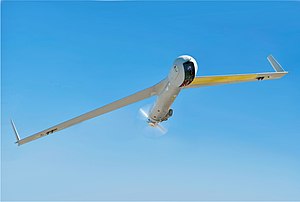 A ScanEagle flying in 2016 A ScanEagle flying in 2016 | |
| General information | |
| Type | Small unmanned surveillance and reconnaissance aerial vehicle |
| National origin | United States |
| Manufacturer | Insitu |
| Primary users | United States Navy United States Marine Corps Royal Australian Navy See Operators section for others |
| History | |
| Manufactured | 2002–present |
| Introduction date | 2005 (U.S. Navy) |
| First flight | 20 June 2002 |
| Developed from | Insitu SeaScan |
| Developed into | Boeing Insitu RQ-21 Blackjack |
The Boeing Insitu ScanEagle is a small, long-endurance, low-altitude unmanned surveillance and reconnaissance aerial vehicle built by Insitu, a subsidiary of Boeing, and is used for reconnaissance. The ScanEagle was designed by Insitu based on the Insitu SeaScan, a commercial UAV that was intended for fish-spotting. The ScanEagle continues to receive improvements through upgrades and changes.
Design and development
ScanEagle is a descendant of another Insitu UAV, the Insitu SeaScan, which was conceived of as a remote sensor for collecting weather data as well as helping commercial fishermen locate and track schools of tuna. ScanEagle emerged as the result of a strategic alliance between Boeing and Insitu. The resulting technology has been successful as a portable Unmanned Aerial System (UAS) for autonomous surveillance in the battlefield, and has been deployed since August 2004 in the Iraq War.
ScanEagle carries a stabilized electro-optical and/or infrared camera on a lightweight inertial stabilized turret system, and an integrated communications system having a range of over 62 miles (100 km); it has a flight endurance of over 20 hours. ScanEagle has a 10.2-foot (3.1 m) wingspan a length of 4.5 feet (1.4 m) and a mass of 44 pounds (20 kg) and can operate up to 80 knots (92 mph; 150 km/h), with an average cruising speed of 48 knots (55 mph; 89 km/h). Block D aircraft featured a higher-resolution camera, a custom-designed Mode C transponder and a new video system. A Block D aircraft, flying at Boeing's test range in Boardman, Oregon, set a type endurance record of 22 hours, 8 minutes.
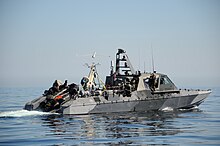
ScanEagle needs no airfield for deployment. Instead, it is launched using a pneumatic launcher, patented by Insitu, known as the "SuperWedge" launcher. It is recovered using the "Skyhook" retrieval system, which uses a hook on the end of the wingtip to catch a rope hanging from a 30-to-50-foot (9.1 to 15.2 m) pole. This is made possible by high-quality differential GPS units mounted on the top of the pole and UAV. The rope is attached to a shock cord to reduce stress on the airframe imposed by the abrupt stop. NavtechGPS worked with the manufacturer of the GPS receiver system to enable the system to work in different environments, expanding the capabilities of the UAS for different mission types and areas of the world. The GPS receiver system NavtechGPS designed for the ScanEagle is still in use today.
Each ScanEagle system costs US$3.2 million (2006). A complete system comprises four air vehicles or AVs, a ground control station, remote video terminal, the SuperWedge launch system and Skyhook recovery system.
Improvements
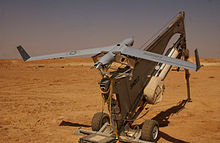
On 18 March 2008, Boeing, with ImSAR and Insitu successfully flight-tested a ScanEagle with ImSAR's NanoSAR A radar mounted aboard. The ImSAR NanoSAR is the world's smallest Synthetic Aperture Radar, weighs 3.5 lb (1.6 kg) and is 100 cubic inches (1.6 litres) in volume. It is designed to provide high quality real-time ground imaging through adverse weather conditions or other battlefield obscurants.
In 2009, Insitu announced the NightEagle, a modified ScanEagle Block E with an infrared camera for night operations.
In August 2010, Boeing announced plans to control ScanEagles from control stations on E-3A AWACS aircraft and on the V-22.
In July 2011, a team of two ScanEagles and another UAV cooperated to search and navigate a mountain area autonomously.
Insitu introduced an improved ScanEagle 2 variant in October 2014 that has a new purpose-built heavy-fuel engine for increased reliability, which increases electrical power but decreases endurance to 16 hours. It also has a larger nose to carry day and night sensors at the same time, an increased payload, and heavier empty and max take-off weights; wingspan, service ceiling, and cruise and top speed remain the same. Other upgrades include a fully digital video system, a better navigation system, Ethernet-based architecture and reduced Electronic Magnetic Interference (EMI), and a new ground control station while using the same launcher and skyhook recovery system. The ScanEagle 2 was made to appeal to the growing commercial UAV market and orders will start being taken in 2015, either new built or as an upgrade for existing ScanEagle aircraft.
In 2014, Insitu began development of the Flying Launch and Recovery System (FLARES), a system designed to launch and recover the ScanEagle without the need to transport and assemble the launch catapult and recovery crane. "It consists of second, quadrotor UAV that carries the ScanEagle vertically and releases it into forward flight. For recovery, the quadrotor hovers trailing a cable that it captures, as it would the cable from the SkyHook crane." FLARES incorporates the VTOL advantages of launch and recovery in confined areas, as well as eliminating the rail and crane equipment, with the flying efficiency of a fixed-wing body. Demonstrations of the system took place from late 2014 to mid-2015, and low-rate production is scheduled for late 2016.
In November 2015, a Royal Australian Navy ScanEagle tested Sentient Vision Systems’s ViDAR optical detection system, turning the UAV into a broad area maritime surveillance (BAMS) asset capable of covering up to 80 times more area in a single sortie than is possible with standard cameras. The self-contained ViDAR system consists of high-resolution digital video cameras and software that analyses image feed and autonomously detects, tracks, and photographs each contact with a 180-degree pan. It can be incorporated into the ScanEagle as two fuselage slices, ahead of and behind the wing, without affecting performance. The ViDAR can cover an area greater than 13,000 square nautical miles (17,000 sq mi; 45,000 km) over a 12-hour mission, and detected small and large surface, air, and even submerged targets during the demonstration.
The Scaneagle 3 is reportedly ITAR-free, meaning that it can be sold without a US Government weapons export licence.
Operational history

The ScanEagle entered service with the U.S. Navy in 2005. In addition to the United States military, the Australian Army also operates the ScanEagle UAV and the Canadian Government also leased the ScanEagle.
On 15 and 16 October 2008, the National Oceanic and Atmospheric Administration (NOAA) conducted three successful test flights of the ScanEagle, launching it from the fisheries and oceanographic research ship NOAAS Oscar Dyson (R 224) in Puget Sound, Washington, flying it remotely from the ship, and recovering it back aboard. In 2009, the NOAA oceanographic research ship NOAAS McArthur II (R 330) began operating a ScanEagle owned by the University of Alaska to monitor the distribution and population of seals in the Bering Sea.
In April 2009, a ScanEagle launched by the U.S. Navy was used during the stand-off between the U.S. Navy and a lifeboat controlled by pirates holding Captain Richard Phillips of the MV Maersk Alabama in the Indian Ocean after a failed hijack attempt.
Insitu announced that the ScanEagle had totaled 500,000 combat flight hours and over 56,000 sorties by July 2011.
In September 2011, Insitu revealed the ScanEagle had been employed by the U.S. Navy in Operation Unified Protector during the 2011 Libyan Revolution. The UAV was launched and recovered by the destroyer USS Mahan (DDG-72) to provide video imagery over three days that located "contacts of interest that no one else could find," which was relayed to the ship and then to the NATO command center by the secure video injection system.

In late May 2013, the U.S. Coast Guard used a ScanEagle to seize over 1,000 lb (450 kg) of cocaine from a fast boat in the eastern Pacific. The ScanEagle was being deployed off the USCGC Bertholf (WMSL-750) during demonstrations to assess UAV use in the Coast Guard. The aircraft was able to maintain visual surveillance of the boat until a cutter was able to interdict the vessel, marking the first time a UAV deployed from a Coast Guard cutter participated in drug interdiction. The trials in May lasted two weeks with 90 flight hours completed. The Coast Guard hopes to begin purchases of unmanned aerial systems by FY 2016, with small UAVs deployed from its National Security Cutter fleet by the following year. Long-term goals are to use unmanned systems to augment their manned fleet, while UAVs on offshore patrol cutters would replace medium endurance cutters.
On 26 July 2013, the ScanEagle became one of the first unmanned aerial vehicles to be granted certification by the Federal Aviation Administration to fly in U.S. airspace for commercial purposes. ScanEagles will be deployed to Alaska off a ship for ConocoPhillips to scout for icebergs and count whales, protecting drilling platforms and fulfilling environmental requirements. The ScanEagle can safely accomplish observation missions in hazardous Arctic locations, which is safer, cheaper, and more environmentally friendly than using manned aircraft. Commercial certification was the result of previous military certification and the Congressionally mandated opening of airspace over much of Alaska to small UAVs. Only four ScanEagles were certified with strict requirements: only one aircraft of the type is allowed airborne at any one time, they cannot fly through clouds or icing conditions, and they cannot take off or land during certain gust and wind conditions. The certifications did not mention line-of-sight control. On 12 September 2013, a ScanEagle with ConocoPhillips conducted its first flight from a research vessel and flew for 36 minutes. On its second flight, the aircraft experienced engine failure. It aborted the flight and landed in the water, as it was programmed to. A boat recovered the downed ScanEagle.
In July 2016, IHS Janes reported that Royal Navy frigates will cease operating the ScanEagle by November 2017. It will likely be replaced by an unknown UAS, chosen through the Royal Navy's Unmanned Warrior exercise in 2016.
The Yemeni Air Force ordered 12 ScanEagles that were never delivered due to the ongoing Yemeni Civil War.
On August 19, 2022 the U.S. announced it was giving 15 ScanEagles to Ukraine as part of a $775M military weapon aid package to assist in their war with Russia.
Iranian capture and reverse engineering claims
Main article: Yasir (UAV)In December 2012, Iran stated it had captured an American ScanEagle that allegedly violated its airspace over the Persian Gulf. Iran later stated it had also captured two other ScanEagles. The U.S. Navy stated that none of its ScanEagles were missing. Photo evidence of a ScanEagle in Iran showed no U.S. military markings. In August 2013, CBC News reported that the Canadian Navy had lost a ScanEagle drone in June 2012. The Navy denied it was obtained by Iran. On 17 December 2012, Iran announced it was starting mass production for a copy of the ScanEagle and has put that UAV into service. Iran later released images of this production line.
In September 2013, a new UAV named Yasir was delivered to Iran's Army ground force; according to Jane's Information Group, the Yasir UAV appears to share the ScanEagle's 1.37 m length and 3.11 m wingspan, although it does have a slightly different twin tail boom and inverted-V tail plane configuration. In unveiling the Yasir, the Commander of the Iranian Army's Ground Forces, Brigadier General Ahmad-Reza Pourdastan, is quoted by the Iranian Fars News Agency as saying it is capable of flying at an altitude of 15,000 ft (4,600 m), has an endurance of 8 hours, and an operational radius of 200 km.
Variants
- ScanEagle X200
- A civilian-variant with a restricted category type certificate issued by the United States Federal Aviation Administration.
- CU-169
- Canadian military designation for the ScanEagle.
- MQ-27A and MQ-27B
- U.S. military designations for the ScanEagle.
- ScanEagle RM1
- Royal Navy designation for basic military variant.
- IAIO Qods Yasir
- Often shortened to "Yasir" or referred to as the "Sayed-2", unlicensed Iranian copy developed from multiple captured ScanEagles.
Operators
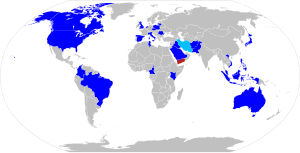
- Royal Australian Navy
- Australian Army (former)
- Indonesian Navy – Eight on order, deliveries expected to be complete by May 2022.
- Lebanese Air Force – 6 on order, all delivered in April 2019.
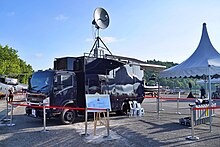
- United States Air Force
- United States Marine Corps
- United States Navy
- United States Coast Guard
- National Oceanic and Atmospheric Administration
- Vietnam People's Navy – six on order as of June 2019.
Specifications
Data from Insitu, USAF, 3W engines
General characteristics
- Crew: none on-board
- Capacity: 11 lb (5 kg)
- Length: 5 ft 1 in – 5 ft 7 in (1.55–1.71 m)
- Wingspan: 10 ft 2 in (3.11 m)
- Empty weight: 30.90–39.68 lb (14–18 kg)
- Gross weight: 39.7 lb (18 kg)
- Max takeoff weight: 58 lb (26.5 kg)
- Powerplant: 1 × 3W International 2-stroke piston engine , 1.5 hp (1.12 kW)
Performance
- Maximum speed: 80 kn (92 mph, 148 km/h)
- Cruise speed: 60 kn (69 mph, 111 km/h)
- Endurance: 20+ hours
- Service ceiling: 19,500 ft (5,950 m)
Avionics
- Variable visual imaging equipment including:
- High resolution day/night camera
- Thermal imaging camera
See also
Related development
Aircraft of comparable role, configuration, and era
Related lists
References
- "Background – CF Mini-UAV candidates – Boeing/Insitu ScanEagle". Canadian American Strategic Review. November 2011. Archived from the original on 27 August 2008. Retrieved 3 December 2011.
The Boeing-Insitu ScanEagle is based on a civil UAV (the SeaScan used by commercial fishers). The ScanEagle layout is the least conventional of CF mini-UAV candidates (the low aspect-ratio wings are swept with endplate vertical tails fitted to either tip). The SeaScan's arrangement is not unique among UAVs – the absence of conventional empennage allows for a pusher propeller – as it frees the nose for the placing of sensors.
- "Historical Snapshot". Archived from the original on 26 June 2017. Retrieved 21 June 2017.
- ^ "Factsheets: Scan Eagle". U.S. Air Force. 15 September 2011. Archived from the original on 10 July 2013.
- ^ "ScanEagle System". Archived from the original on 4 November 2014. Retrieved 13 November 2014.
- "Boeing ScanEagle achieves major flight milestones", Aerotech News & Review, November 23, 2006.
- "ScanEagle and Integrator UAVs, navigation and capture". NavTechGPS. Archived from the original on 16 February 2016. Retrieved 9 February 2016.
- "Error – IMSAR" (PDF). Archived from the original (PDF) on 13 November 2014. Retrieved 13 November 2014.
- "Boeing Flight-Tests 2-Pound Imaging Radar Aboard ScanEagle Unmanned Aircraft" Archived March 20, 2008, at the Wayback Machine. Boeing, 18 March 2008.
- Trimble, Stephen. "Insitu Unveils NightEagle Unmanned Air System" Archived 2016-08-16 at the Wayback Machine. Flight International, 12 November 2009.
- "ScanEagle makes move on NATO AWACS, V-22". Archived from the original on 18 August 2010. Retrieved 16 August 2010.
- Mortimer, Gary. ScanEagle, Procerus Unicorn communicate over search area Archived 2011-09-23 at the Wayback Machine 18 August 2011
- Insitu introduces ScanEagle 2 Archived 2014-10-29 at the Wayback Machine – Flightglobal.com, 29 October 2014
- Insitu Unveils 'ScanEagle 2' With More Payload Options Archived 2014-11-29 at the Wayback Machine – Ainonline.com, 29 October 2014
- ScanEagle 2 UAV prepares for takeoff Archived 2014-11-04 at the Wayback Machine – Gizmag.com, 30 October 2014
- Insitu Launches New ScanEagle 2 UAS - Defensenews.com, 31 October 2014
- Quadcopter Launches ScanEagle Drones From Its Belly, Catches Them In Mid-Air Archived 2015-11-03 at the Wayback Machine – Popsci.com, 2 November 2015
- Insitu Launches UAV From UAV Archived 2016-01-28 at the Wayback Machine – Aviationweek.com, 16 November 2015
- Sentient ViDAR trial turns Royal Australian Navy ScanEagle UAV into BAMS platform Archived 2016-03-02 at the Wayback Machine – Navyrecognition.com, 24 February 2016
- Corfield, Gareth (18 May 2018). "Eye in the sea skies: Insitu flies Scaneagle 3 UAV in first public demo". The Register. Archived from the original on 21 May 2018. Retrieved 20 May 2018.
- "Boeing Awarded Navy Contract for ScanEagle Services". Boeing. 6 June 2008. Archived from the original on 12 June 2008.
- Army Technology/ Archived 2011-02-07 at the Wayback Machine, Defense Jobs of Australia
- "Canadian military acquiring new helicopters, drones" . CBC News
- McLean, Sheila (29 October 2008). "Unmanned Aircraft Launched from NOAA Ship Oscar Dyson" (Press release). NOAA. Archived from the original on 4 December 2014. Retrieved 13 November 2014.
- "noaa.gov National Marine Mammal Laboratory Dyson UAS Test Flights". Archived from the original on 6 July 2014. Retrieved 14 June 2014.
- "Bering Sea flights prove viability of university's unmanned aircraft". SitNews. 15 June 2009. Archived from the original on 24 September 2015. Retrieved 13 November 2014.
- U.S. Navy Photo 090409-N-0000X-926 Archived 2015-01-09 at the Wayback Machine. Navy News Service, retrieved 1 April 2011.
- Faram, Mark D. "Maersk Alabama rescue was highlight of cruise". Navy Times, 19 September 2009.
- Drwiega, Andrew. "ScanEagle adds 10,000 hours per month as Integrator comes in to play". Navy Times, 17 May 2009.
- Mortimer, Gary (19 July 2011). "Insitu's ScanEagle Proves Consistent Reliability Over 500,000 Combat Flight Hours". UAS News. Archived from the original on 14 September 2011. Retrieved 27 July 2011.
- Scan Eagle Proved Worth Over Libya, Maker Insitu Says Archived 2016-03-04 at the Wayback Machine – Ainonline.com, 19 September 2011
- "UAV a success for Coast Guard in major drug bust" Archived 2013-08-13 at the Wayback Machine Military Times, 10 August 2013
- "FAA certifies two UAVs for commercial operations" Archived 2013-08-04 at the Wayback Machine FlightGlobal, 26 July 2013
- ConocoPhillips confirms ScanEagle down Archived 2013-10-03 at archive.today – sUASNews.com, 2 October 2013
- Scott, Richard. "RN frigates to lose shipborne UAS capability". IHS Janes. Archived from the original on 15 July 2016. Retrieved 16 July 2016.
- "Royal Navy will use Unmanned Warrior to assess ScanEagle replacement". Flightglobal.com. Flightglobal. 11 August 2016. Archived from the original on 12 August 2016. Retrieved 11 August 2016.
- Yemen; ScanEagle UAV order Archived 2014-10-14 at the Wayback Machine – Dmilt.com, 8 October 2014
- Baldor, Lee (19 August 2022). "US announces new military aid, drones for Ukraine". AP News. Associated Press. Retrieved 20 August 2022.
- "Iran says it captured two more U.S. drones before ScanEagle". Haaretz.com. 17 December 2012. Archived from the original on 10 July 2014. Retrieved 13 November 2014.
- "Iran Claims It Captured Another 'Foreign Enemy Drone'". Huffington Post. 23 February 2013. Archived from the original on 26 February 2013. Retrieved 7 May 2013.
- "Iran (News), Middle East and North Africa (News) MENA, World news, Drones (News) unmanned drones, CIA, US news, Espionage spies spying (News)". The Guardian. London. 7 February 2013. Archived from the original on 2 February 2017. Retrieved 14 December 2016.
- "Iran denies it captured a foreign 'enemy drone'". Fox News. 24 February 2013. Archived from the original on 10 June 2013. Retrieved 7 May 2013.
- "Iranian TV shows off 'captured US ScanEagle drone'". BBC News. 4 December 2012. Archived from the original on 1 November 2018. Retrieved 20 June 2018.
- Erdbrink, Thomas (4 December 2012). "U.S. Disputes Iran's Claim of Captured Drone". The New York Times. Archived from the original on 2 January 2017. Retrieved 26 February 2017.
- "Iran Hunts US ScanEagle Drone over Persian Gulf". Archived from the original on 7 December 2012. Retrieved 9 January 2014.
- Diversions Archived 2013-02-11 at the Wayback Machine – Strategypage.com, 6 December 2012.
- North, Rob (8 August 2013). "Canadian navy loses drone in hostile waters: report". CBC News. Archived from the original on 9 August 2013. Retrieved 9 August 2013.
- "Iran says its producing ScanEagle drone". Archived from the original on 26 December 2012. Retrieved 7 May 2013.
- "Iran shows off 'new' Yasir UAV". Archived from the original on 2 October 2013. Retrieved 2 October 2013.
- "Iran has unveiled a new drone based on a captured U.S. Boeing ScanEagle". The Aviationist. 29 September 2013. Archived from the original on 3 November 2013. Retrieved 13 November 2014.
- "FAA Type Certificate Data Sheet Q00017LA" (PDF). Archived (PDF) from the original on 28 December 2016. Retrieved 1 April 2015.
- Afghan Army's ScanEagle UAV made inaugural flight Archived 2016-04-21 at the Wayback Machine – Armyrecognition.com, 20 April 2016
- "Taliban seizes US military equipment including drones, humvees and MRAPs". independent.co.uk. Retrieved 13 August 2020.
- ^ "From Dolphins to Destroyers: The ScanEagle UAV" Archived 2013-05-17 at the Wayback Machine. Defense Industry Daily, 25 April 2013.
- "Boeing Australia Limited to provide ScanEagle UAV to ADF in Afghanistan - Australian Defence Magazine". australiandefence.com.au. Retrieved 5 June 2020.
- "Unmanned Aerial Vehicles". army.gov.au. Retrieved 5 June 2020.
- "Brazilian Navy Details ScanEagle Acquisition – UAS VISION". UAS Vision. 30 December 2019.
- "Insitu Gets $9M ScanEagle Contract for Cameroon". 7 October 2015. Archived from the original on 3 July 2016. Retrieved 3 January 2016.
- DeYoung, Karen (23 March 2011). "Colombia began using U.S. drones for counterterrorism in 2006". The Washington Post. Archived from the original on 26 September 2017. Retrieved 24 August 2017.
- Colombia; US donates ScanEagle UAV's to FAC Archived 2014-01-04 at the Wayback Machine – Dmilt.com, March 19, 2013
- "La Aviación Naval de la Armada de Colombia presentó sus nuevos drones de vigilancia NightEagle". 31 July 2017. Archived from the original on 1 August 2017. Retrieved 1 August 2017.
- Rahmat, Ridzwan (23 February 2018). "Indonesian Navy to receive four ScanEagle UAVs in 2018". IHS Jane's 360. Singapore. Archived from the original on 23 February 2018. Retrieved 24 February 2018.
- Rahmat, Ridzwan (3 April 2019). "Insitu receives contract to supply Indonesia with six ScanEagle UAVs". Jane's 360. Singapore. Archived from the original on 3 April 2019. Retrieved 3 April 2019.
- ^ Rahmat, Rahmat (2 June 2019). "Insitu receives contract to supply four Southeast Asian services with ScanEagle UAVs". Jane's 360. Singapore. Archived from the original on 3 June 2019. Retrieved 3 June 2019.
- "Iraq to receive ScanEagle UASs" Archived 2016-08-14 at the Wayback Machine. Jane's Defence Weekly, 10 August 2016.
- "Insitu: contract with the Italian Navy for ScanEagle UAS aircraft delivery". Avionews.it. 18 September 2013. Retrieved 18 September 2013.
- "Insitu delivers first ScanEagle for Japanese armed forces". Jane's Defence Weekly, 13 May 2013.
- "Insitu Pacific Delivers ScanEagle UAS for the Japanese Ground Self Defense Force" Archived 2013-12-03 at the Wayback Machine. Insitu.com, 14 May 2013.
- Archived 2016-05-02 at the Wayback Machine Nairobi News, 26 Feb 2016
- Egozi, Arie (14 December 2017). "Lebanon to receive MD530Gs, ScanEagles from USA". Flight Global. Tel Aviv. Archived from the original on 22 December 2017. Retrieved 22 December 2017.
- "US to give Lebanon its first attack helicopters". AFP. 13 December 2017. Retrieved 22 December 2017.
- Binnie, Jeremy (3 April 2019). "Lebanon receives ScanEagle UAVs". Jane's 360. London. Archived from the original on 3 April 2019. Retrieved 3 April 2019.
- "Scan Eagle UAS Procurement FMS Lithuania". Archived from the original on 3 January 2017. Retrieved 2 January 2017.
- ""Karinės paslaptys", 2016-12-04". 4 December 2016. Archived from the original on 25 February 2017. Retrieved 16 January 2017.
- Stevenson, Beth. "DSA12: Insitu signs Malaysian ScanEagle deal" Archived 2013-04-14 at the Wayback Machine. Shephardmedia.com, 19 April 2012.
- "Insitu Announces ScanEagle Contract with Netherlands Ministry of Defense". 19 March 2012. Archived from the original on 9 January 2015. Retrieved 31 July 2013.
- "Pakistan Navy inducts Boeing Scaneagle UAV and ATR transport plane". 31 August 2016. Archived from the original on 5 September 2016. Retrieved 31 August 2016.
- "Pak Navy gets third ATR aircraft, Scan Eagle Unmanned Aerial System – Pakistan – Dunya News". 14 February 2008. Archived from the original on 3 September 2016. Retrieved 31 August 2016.
- "US solicitation reveals Philippines to be ScanEagle operator". IHS Jane's Defence Weekly. 7 June 2017. Archived from the original on 7 June 2017.
- "Philippines Eye Heavy Metal" (PDF). ADAS 2018 Daily News. Retrieved 25 January 2022.
- "Scan Eagle Takes Aim at Europe". Archived from the original on 21 March 2010. Retrieved 2 January 2011.
- "Scan Eagle Modifications and Repairs - FMS Romania - Federal Business Opportunities: Opportunities". 19 March 2013. Archived from the original on 4 January 2015. Retrieved 15 October 2021.
- "Ce drone mai are Armata Romana?!". Romania Military (in Romanian). 4 January 2015.
- "ScanEagle Drone Shot Down By Yemeni Rebels, But Do The Saudis Fly Them?". International Business Times. 1 November 2019.
- "Minister for Defence Visits Republic of Singapore Navy's Fleet". Archived from the original on 4 August 2012. Retrieved 16 May 2012.
- Yanez & Rodriguez 2018, p. 83
- "From Dolphins to Destroyers: The ScanEagle UAV". Defense Industry Daily. 9 November 2014. Archived from the original on 18 November 2014. Retrieved 13 November 2014.
- "British MoD Inks Deal for Boeing ScanEagles". Defense News. 18 June 2013. Archived from the original on 20 June 2013. Retrieved 19 June 2013.
- "Scan Eagle". af.mil. Archived from the original on 4 April 2018. Retrieved 2 April 2018.
- "On duty with U.S. Marines, ScanEagle in league of its own". ainonline.com. Archived from the original on 14 April 2018. Retrieved 2 April 2018.
- "Insitu receives contract for U.S. Navy Special Warfare ScanEagle support". upi.com. Archived from the original on 14 April 2018. Retrieved 2 April 2018.
- "Unmanned Aircraft System". www.dcms.uscg.mil. Archived from the original on 25 March 2018. Retrieved 22 September 2018.
- "ScanEagle UAS ready for launch on the NOAA ship McArthur II". Archived from the original on 14 April 2018. Retrieved 2 April 2018.
- "U.S. announces $800 million more military aid for Ukraine". PBS NewsHour. 19 August 2022. Retrieved 23 August 2022.
- "ScanEagle System" Archived 2013-01-26 at the Wayback Machine. Insitu. Retrieved December 26, 2013
- "Scan Eagle fact sheet". Af.mil. 1 November 2007. Archived from the original on 27 December 2013. Retrieved 26 December 2013.
- "3W International Multi-Fuel & Gas Engines". Archived from the original on 5 September 2016. Retrieved 24 July 2019.
- Yanez, Roberto; Rodriguez, Alex (February 2018). "Flotilla de Aeronaves". Air International. Vol. 94, no. 2. pp. 78–83. ISSN 0306-5634.
External links
| External image | |
|---|---|
| Boeing military aircraft | |
|---|---|
| Fighters/attack aircraft | |
| Bombers | |
| Piston-engined transports | |
| Jet transports | |
| Tanker-transports | |
| Trainers | |
| Patrol and surveillance | |
| Reconnaissance | |
| Drones/UAVs | |
| Experimental/prototypes | |
| Current United States Coast Guard aircraft | |
|---|---|
| Search and rescue | |
| Helicopters | |
| UAVs | |
| VIP transports | |
| USAAF/USAF UAV designations 1924–1962, tri-service designations 1962–present | |||||||||
|---|---|---|---|---|---|---|---|---|---|
| USAAF designations (1924-1947) |
| ||||||||
| USAF designations (1948-1962) | |||||||||
| Tri-service designations (1962-present) |
| ||||||||
| |||||||||
| Canadian Armed Forces post-1968 unified aircraft designations | |||||||||||||||||||
|---|---|---|---|---|---|---|---|---|---|---|---|---|---|---|---|---|---|---|---|
| Numerical Sequence |
| ||||||||||||||||||
| Role |
| ||||||||||||||||||
| Not assigned | |||||||||||||||||||
| Italian Armed Forces aircraft designation system, 2009–present | |
|---|---|
| 1–100 | |
| 101–200 | |
| 201–400 | |
| 401–2006 | |